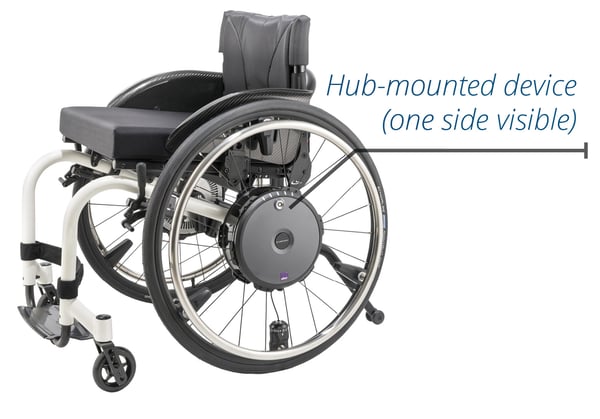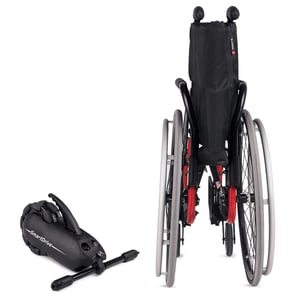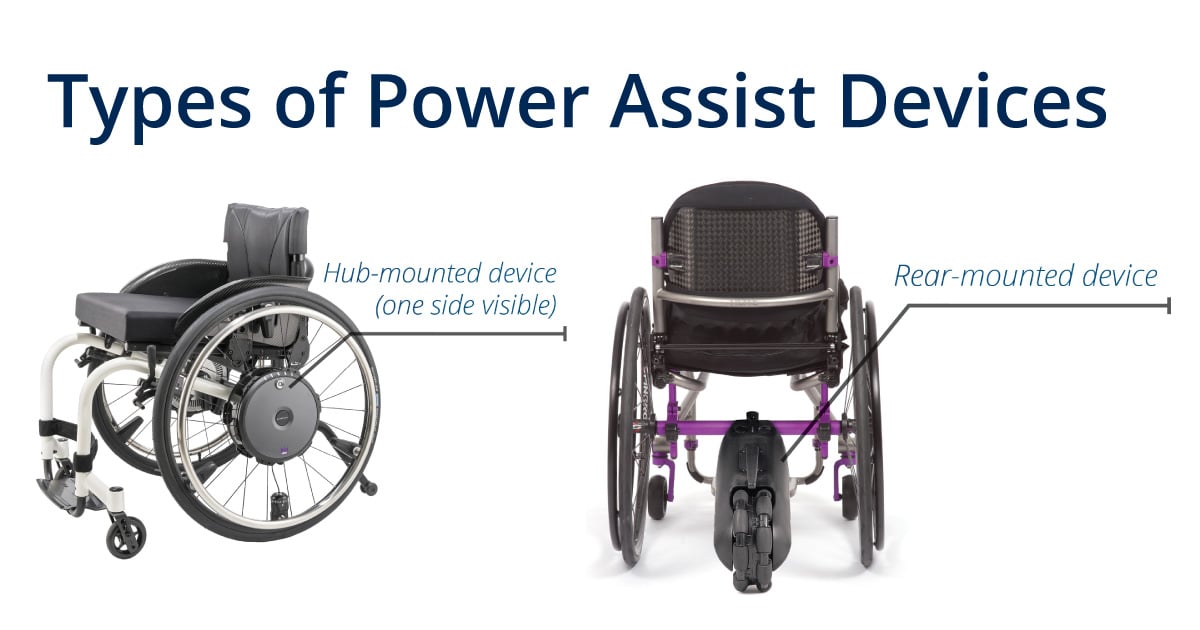In our manual wheelchair guide blog series, we've discussed a number of topics concerning manual wheelchairs. There are different types of power assist devices on the market today. Below we discuss each option along with the benefits and considerations of each style of device.
Hub-Mounted Power Assist
With this style of power assist, the motors and the batteries are in the wheels. They are activated through force on the pushrims. That force triggers sensors which signal the motors to propel the wheels forward.

| Benefits | Considerations |
|
Can be programmed for sensitivity, boost, and speed |
Adds weight to the wheelchair |
|
Very little force is required to activate |
Wheels need to be removed to facilitate transport in a vehicle |
|
Assist is on every push |
Need to protect the wheels during transport, prevent damage to sensors |
|
May offer slope deceleration assist which can help maintain a comfortable speed when going down grades and ramps |
When the motors are not engaged (short distances, select environments) the wheels add weight to every push |
|
Can be used with folding or rigid MWCs |
If battery dies, adds resistance to wheels |
|
With programming, if there is a strength discrepancy from left or right, it may be able to compensate and maintain the desired path |
Modifications to the WC may be necessary such as added hardware and increased WC width, which could limit access to wheels and accessibility to narrow spaces |
|
Also require "power adaptable or power reinforced frame" from manufacturer |
|
|
Eliminates the ability to use wheel camber |
|
|
Some users consider adapted vehicles to avoid removing wheels for transport, which is a considerable cost |
Rear-Mounted Power Assist
This style of power assist is a detachable, single motor component. It attaches to the wheelchair axle and wearable devices or controllers signal the motor via Bluetooth or switches to start, accelerate, and stop. Maneuvering and stopping the WC is still guided by the user's hands on the handrims.

| Benefits | Considerations |
|
Easily removed when transferring manual wheelchair (MWC) into a vehicle, for transport, and charging |
User must be able to control rate of descent down grades and ramps |
|
On-demand function. Not necessary to have on the wheelchair (WC) when not needed |
Disc breaks can be added to the wheelchair to assist with deceleration, but are a separate device |
|
Acceleration and top speed are programmable, allows for safe operation |
Certain amount of training may be required for the user to safely operate |
|
Programmable to meet different needs |

|
|
Lightest weight option |
|
|
Freewheels when off or if battery runs out; minimally increased resistance |
|
|
Does not compromise configuration of the wheelchair, which is significant for pushing without the device |
|
|
Allows for more user-defined settings for use in different environments and when selecting input devices (control via Bluetooth wearable or a hard-wired switch) |
|
|
Weather-sealed / water-resistant |
|
|
Can be used with folding or rigid MWCs |
|
|
Can be used with manual tilt-in-space wheelchairs to help caregivers and/or help the users with mobility |
 Stacey Mullis, OTR/ATP
Stacey Mullis, OTR/ATP
Director of Clinical Marketing
Stacey serves as Director of Clinical Marketing for Permobil. A practicing OTR for over 20 years, she has experience in school-based pediatrics, inpatient rehabilitation, long term care, and home health. With her interest in wheelchair seating and positioning, Stacey engaged the challenges of providing appropriate seating in various clinical settings. She now uses this experience to develop programs and resources to educate clinicians on the principles of seating and wheeled mobility. She is passionate about equipping clinicians and through her previous role as Director of Clinical Education with Comfort Company and now with Permobil she has taught nationally and internationally to increase therapist capacity in this specialty area. Mullis graduated from Western University in London, Ontario, Canada with a BA Linguistics and BSc Occupational Therapy. She is a member of the NCOTA, CTF Executive Board, NRRTs, RESNA, and AOTA.
 Ginger Walls, PT, MS, NCS, ATP/SMS
Ginger Walls, PT, MS, NCS, ATP/SMS
Director of Clinical Sales and Education
Ginger has 25 years of experience as a physical therapist in the area of neuro rehab and wheelchair seating/mobility. She directed the Outpatient therapy clinics and the Seating/Mobility Program at Medstar National Rehabilitation Hospital in Washington, D.C. Additionally, Ginger has provided a variety of continuing education courses and lectures in the area of seating/mobility for many years. She has presented at major industry conferences including ISS, RESNA, and the PVA Summit. Ginger took on the role of Clinical Education Specialist for Permobil in 2015 and was appointed Director of Clinical Sales and Education in 2020.
